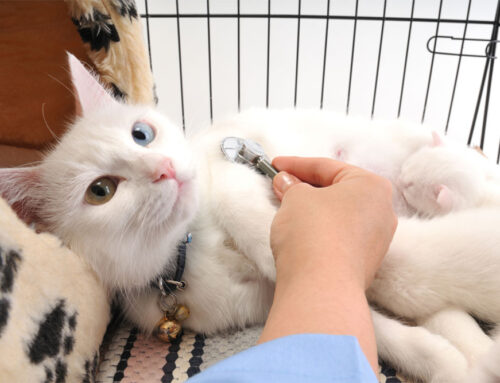Dental health is an important aspect of cats’ and dogs’ well-being, but dental care is often overlooked. February is National Pet Dental Health Month, a good time to assess your four-legged friend’s oral health and hygiene. Our Valley Center Veterinary Clinic team takes the mystery out of your pet’s mouth health by providing tips on essential dental care.
Misconceptions about pet dental health
For many years, pet owners believed that dogs and cats had naturally smelly breath. Another misconception has been that chewing a bone or hard kibble was enough to keep pets’ teeth clean. Many pet owners rarely looked at their pets’ teeth closely or concerned themselves with their furry pal’s dental hygiene.
We know now that dental health is intricately linked to overall health. We understand that chewing food isn’t enough to keep the teeth clean. Dogs and cats require at home and professional dental care, just like us. Professional veterinary dentistry and pet owner education are gradually eradicating these age-old ideas.
The root of pet dental problems
According to the American Veterinary Medical Association (AVMA), more than 80% of dogs and 70% of cats have dental disease. This startling fact illustrates how oral health in pets has been largely neglected.
Dental disease (i.e., periodontitis) is caused by plaque and tartar (i.e., calculus) buildup. Without toothbrushing and regular professional dental examinations, your pet can develop dental disease, a progressive condition that worsens over time and becomes increasingly difficult to treat. Plaque and tartar allow bacteria to flourish. Gingivitis (i.e., gum inflammation) can lead to advanced periodontitis. Pockets within the gumline form between an affected tooth and its supporting tissue, degrading the tooth’s supportive structures, including the jawbone.
Late-stage periodontitis often includes tooth and bone loss, pain, infections, and abscesses. What’s worse, chronic infection and bacteria can lead to heart, liver, and kidney diseases, which may shorten an affected pet’s life.
How to improve your pet’s dental health at home
Dental disease poses severe health issues, and many pets suffer needlessly. However, you can help prevent your pet from developing dental disease and tooth decay by following these tips:
- Brush your pet’s teeth daily — At any pet supply store, you will find assorted pet toothbrushes and pet-safe toothpaste. Look for a soft-bristled toothbrush suitable for your pet’s size. Pet toothpaste comes in several flavors to add to the appeal. Never use toothpaste intended for people, since it contains ingredients that are toxic to pets.
Brush your pet’s teeth each day or at a minimum every other day to achieve the best results. Introduce toothbrushing sessions by providing lots of treats as rewards. Acclimate your furry pal to the toothbrush by starting gradually, focusing only on the front incisors. When your pet is comfortable with the routine, move to the back and side teeth, ensuring you brush each tooth’s entire surface. Talk with our Valley Center Veterinary Clinic team if you would like toothbrushing instructions or a demonstration.
- Use dental treats and toys — Dental chews are appropriate for complementing your pet’s toothbrushing. To ensure you provide your pet with effective dental health products, use those that have the Veterinary Oral Health Council (VOHC) seal of acceptance, because these items have been proven to help prevent plaque buildup. You should also give your pet dental toys that have ridges and are sturdy enough for ongoing chewing. These toys are also helpful in reducing plaque and tartar accumulation.
- Add dental supplements to your pet’s bowl — Water and food dental additives are great for enhancing healthy mouth bacteria. These products are available in many forms such as powder, gel, or liquid. When added to your pet’s food or water, these products can keep plaque, tartar, and toxic bacteria from developing. Their efficacy depends on regular use over time. If you opt for these products, consult with our team to help you select the best ones for your furry friend.
Pet dental health relies on regular professional dental exams

The best way to keep your pet healthy is through yearly or twice-yearly wellness examinations. Through these visits, our team is able to establish your pet’s health baseline and detect any changes to their well-being. During your pet’s checkup, we will assess their teeth and gums. Our team recommends pets have annual professional dental cleanings, along with X-rays. This allows us to determine whether trouble is brewing below the gumline.
During your pet’s professional dental cleanings, we eliminate plaque and tartar from their teeth and assess whether your furry pal has experienced oral tissue and bone damage. Professional dental cleaning is by far the most effective way to keep your pet’s teeth in tip-top shape.
Have you noticed that your pet’s breath is unpleasant? Do you see brown or yellow discoloration on their teeth? If so, take action. To establish your pet’s dental treatment plan, contact our team at Valley Center Veterinary Clinic and promote your furry pal’s overall well-being.







Leave A Comment